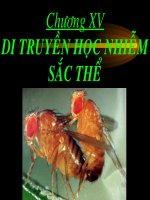Bài giảng Lý thuyết (cơ sở) di truyền học nhiễm sắc thể
Bạn đang xem bản rút gọn của tài liệu. Xem và tải ngay bản đầy đủ của tài liệu tại đây (19.99 MB, 58 trang )
LY THUYET (CO SO)
DI TRUYEN HOC NHIEM SAC THE
PGS.TS. Dinh Doan
Long
Overview of today’s topics:
1st theme. DNA replication and repair
1.
2.
3.
The end replication problem and telomerase
How cells repair replication mistakes
Other types of DNA repair
2"¢ theme. Meiosis and Genetic Variability
1.
Vocabulary of meiosis
2.
The process of meiosis
3.
Mistake in melosis and sex determination
3'4 theme. Sex linkage and pedigrees
1.
2.
3.
How to know you are dealing with one or two genes
X-linked inheritance
Human pedigrees
—
———
a
J
-
DDL@VNU-SMP
How is new DNA
synthesized?
Matt Meselson & Frank Stahl, 1958
They wanted to distinguish between 3 different models
for how DNA might be copied
each gives rise to a new
PHOT Phước,
EPDM
Hybrid
¿
š
Generation 1
15N
Generation 2
Hybrid
!4N
Hybrid
đại
ý
14N
After
2 generations:
1/2 low-density DNA
1/2 intermediate-density DNA
| he
double-stranded structure
i=
Generation 0
PDX
complementary strand
gives rise to a new
Dispersive
Double-stranded DNA
replicated over short
stretches
ar Pm
The strands separate and
Conservative
Double-stranded DNA
2
Semi-conservative
—
a
After 2 generations:
1/4 high-density DNA
3/4 low-density DNA
After 2 generations:
All intermediate-density DNA
DDL@VNU-SMP
Meselson-Stahl:
Top of centrifuge
tube (lower density)
The results
"S7
~ ˆ
14N _
Hybrid —
15N
Bottom of centrifuge
tube (higher density)
===
—— ^”
——..
wu
—-
__—.._—
*š
After 2 generations:
1/2 low-density DNA
1/2 intermediate-density
DNA
Ị
6
NI
„
2
Generation
After generation
1:
DNA all of intermediate density
After generation 2:
Y2 DNA of low density
Y2 DNA of intermediate density
This result was only consistent with semi-conservative replication,
in which each parental strand is used to synthesize a
complementary strand
II
DDL@VNU-SMP
Let's take a closer look at what happens during DNA synthesis
Deoxynucleoside
triphosphates are
added to a template.
0
DNA polymerase
BẾP
catalyzes this
:
is the enzyme that
reaction.
annealed
primer
(A, G, C, or T)
|
.
Y
o:
:
/ growing end of DNA
= _/template strand
DDL@VNU-SMP
DNA Is always synthesized in the 5’ > 3’ direction
C-
=
a
2
O
Sas
Oo
(
oO
®
ứ)
=
O
>
O
O
How can DNA be
synthesized in both
directions at the
same time?
B.
=.
°
2
z
>
—
©
a
a
The Replication Fork:
DNA synthesis starts at an origin and proceeds in both directions
(a) A chromosome being replicated
(b) Bacterial chromosomes have a single point of origin.
_
§
go
pOPY,
"eg
3
>
Đ
:2 —~ §
Bạn
3
§
“2À
ay
se
\
IVP
Mp
%a
2
dy
> Old DNA
4
—New DNA
\. \ Replication/ /
proceeds in
Origin of
both directions
replication
Replication
(c) Eukaryotic chromosomes have multiple points of origin.
09000%0%016z
oo
i
| L7
0%0%.0%63
oe
`
| 5,
mms...»
....
30%:0%40%63
Old DNA
`New DNA
`
Replication proceeds
directions from
each
fork
—_
=o
—=Ää
B.
ald
Roles
®mŠ...-›}`
KVOVIVO
in both
starting noint
> But what about the other strand?
II
5
DDL@VNU-SMP
Solution:
DNA synthesis is
continuous on one
strand (the leading
strand) but
discontinuous on
the lagging strand.
3 T
5
Nx
/
Newly
iy
Template strands
r
Unwinding—
and replication
synthesized DNA
Lagging strand
Okazaki fragments
53
Discontinuous
SK
5:3
s
On
yes
2
Leading strand
Continuous
DNA synthesis
Bi-directional DNA synthesis starting at an origin of replication
Okazaki
fragments
|
Origin
i
Directionof
fork movement
=
\
`
¬...
"
Direction of
fork movement
—
⁄” Lagging HE
Leading
Laggino PA
_—
Origin
Question:
ae
\
:
Okazak|
fragments
Does point ‘A’ represent a 5’ or 3’ end of DNA?
II
DDL@VNU-SMP
Leading strand synthesis:
Primase synthesizes RNA primer
3
Topoisomerase relieves twisting forces
PY
5’
PUP VIVIVIVIVIVHU
Helicase opens double helix
Single-strand DNA-binding proteins (SSBP) stabilize single strands
1. DNA is opened, unwound, and primed.
Sliding clamp holds DNA polymerase in place
fi ‘j
đd
Si eo
RNA primer
Leading strand
5
,
“a
DNA polymerase Ill works in 5— 3’ direction, synthesizing leading strand
TRE
La vs. Àve.es KAA
Th
a at
l/®›
>/0)9?ao002020
00eh 00
0000%0044d048 5
,P
—|
2. Synthesis of leading strand begins.
DDL@VNU-SMP
Lagging strand synthesis:
5
|
1. Primase synthesizes
RNA primer.
S
RNA |
sư
aNSOULE i
per
<<
44 4
wed
Fay
:
SSBPs
`Primase
™ Helicase
Okazaki fragment
2. DNA polymerase III
works in 5'-> 3’ direction,
3
synthesizing first Okazaki
fragment of lagging stand.
3. Primase and DNA
polymerase lll synthesize
another Okazaki fragment.
5
+
|
=
-
¬
ne
HH
\. _ Sliding
A &Ê.
“Me
Tin? Qn?
Vin 51?
eT a
5
ns
Vin? Unc NeDaee
3
~ Topoisomerase
:
HEL vovovouess
=
~>
clamp
DNA polymerase III
Okazaki fragment
UAL mm
5 ee
mm
Okazaki fragment
,
`
:
(%,
1
1
a
oweib
ii
4
LÝ
T
EN”
1,1% «7
NUR
A
“
a
7
5
` 4/
=>
DDL@VNU-SMP
Lagging strand synthesis (continued):
35 mmmmm
TT
có—
— „ ĐNA polymerasel
a
m_
fe
`
Seah.
ey
pe
8. ae
&” 3:
”
C2
*
«
O1
4. DNA polymerase | removes ribonucleotides of primer, replaces them with
deoxyribonucléotides in 5
3' direction.
3
- DNA ligase
°
|
fi.
So
X
brews
5’
5. DNA ligase closes gap in sugar-phosphate backbone.
DDL@VNU-SMP
The trombone model explains how leading and lagging strand
synthesis can be coordinated
ran
strand
><
DNA polymerase
y-complex
sliding ~_
clamp
gì
OI
sae.
T-protein
$
>
=
1)
7
laqơinn
—.`
To
A
iy
“_
.
NOT
`4
strend
DMÀ.gbbndrä
SSB bound
%
SERN
2
“
Link to web animation of DNA replication:
/>
DNA replication in eukaryotes...same logic,
different protein names
_— RPA
L5
⁄
Lagging strand
Pol a+
Primase
5'
3—
&S
ea
LẠ .&..á
..
LAS
`
_`
8722
3'
MCM2-7
Pal«
Helicase
i
PCNA
Leading strand
http:/www.nature_comí/cr/ioumal/v18/n1/mages/cr20084f2
Ipg
What happens when the replication fork reaches the end of
a linear chromosome?
4
PUP
coer
x
DNA polymerase
Sliding clameÂ
WI WCOWOUCPUCIUO WYN
Sener
%
Lagging strand
SSBPs
a
`
ơ=.`/
Helicase
1. Helicase unwinds end of DNA helix (at end of chromosome).
ADEN
EN
NNN
NN
RNA primer
2. DNA polymerase completes the leading strand. Primase synthesizes RNA primer at end
of lagging strand.
|
3
5
'
What happens when the replication fork reaches the end of
a linear chromosome?
Aly qh lu rh | A
rT Wd
ly
Ply ql”
li if
\
WP DD DD WP WP DP Ts
t Ni f} lad
AN
ohh
bd
\„⁄
z
oe
aT
Last Okazaki fragment
3. DNA polymerase synthesizes the last Okazaki fragment in lagging strand.
WAU
LANL NINN
DP DP DI DIDI DP DIDI DI DIDI DIDI
Tes
Unreplicated end
4. No DNA synthesis occurs after primer is removed (no free 3’ end for DNA polymerase);
chromosome is shortened.
Many cells use telomerase to solve the end replication problem
The ends of chromosomes
(telomeres) have many copies of
a TTAGGG repeated sequence.
»
Telomerase is an enzyme that uses
an RNA template to add nucleotides
to the ends of chromosomes
Telomeres
extended by
telomerase
can
then be replicated
DDL@VNU-SMP
Telomeres and Telomerase: 2009 Nobel Prize
Elizabeth Blackburn, Carol Greider, Jack Szostak
In the late 1980’s, Calvin Harvey showed that telomere
shortening can cause cells to exit the cell cycle and
become senescent (the “telomere clock” hypothesis).
Telomerase is expressed in germline cells but is turned
off in most somatic cells.
Therefore, it is thought that most somatic cells have a
limited number of divisions that they can undergo.
Can aging be reversed by stimulating expression of telomerase in
key stem cell populations?
II
DDL@VNU-SMP
What happens when mistakes are made during replication?
- Based on the physical chemistry of the hydrogen
bond, one would predict an error
rate of 1 in every
`
10,000 -100,000 bases polymerized.
m'ef^®ke
“~~
- The E. coli bacterium has 4,639,000 base pairs.
A 1 in 100,000 error rate would result in about 92 incorrect bases
introduced with every round of replication.
> Unacceptable! Many of these would result in mutations
that have a negative impact on the cell.
- Humans have over 3 billion base pairs in their genomes.
prevents mistakes from being made during replication?
II
What
DDL@VNU-SMP
One source of mistakes: A small percentage of the time
bases will take on a rare tautomeric form
Normal
a
~
bases
amino
Base tautomers
Imino
This tautomer of C
will base pair with A
keto
enol
ee
_ee
This tautomer of G
will base pair with T
™ H-bond donor
™* H-bond acceptor
When this occurs on the incoming dNTP during replication, DNA polymerase
will incorporate an incorrect base at the 3’ end of the growing chain
II
5
DDL@VNU-SMP









